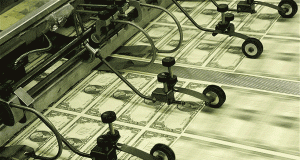Will The Fed Really Cut QE Before Year’s End?
 A couple of top economists shocked the market yesterday. According to Bloomberg, two former Fed economists said the central bank will cut its monthly bond buying from $80 billion to $50-$60 billion in the fourth quarter.
A couple of top economists shocked the market yesterday. According to Bloomberg, two former Fed economists said the central bank will cut its monthly bond buying from $80 billion to $50-$60 billion in the fourth quarter.
The two see such a cut as the first step in a three-step strategy to wind down the Fed’s latest round of quantitative easing. The first cut would be followed by a second to $30 billion.
And after the second cut, the Fed would stop buying bonds under the program all together.
Such a plan, Michael Feroli, chief US economist at JP Morgan Chase, told Bloomberg “would be enough of a runway to know and gauge the effects of what they’re doing, but not too long a runway where it’s a painfully interminable process.”
The logic behind a gradual reduction in QE spending makes sense.
If the Fed were to end QE entirely all at once, it could start a panic and send interest rates soaring. A gradual approach should lessen the impact and help avoid major disruptions to the market.
With that said, it’s hard to see the Fed reducing, let alone completely eliminating, QE any time soon.
The Fed’s official policy is that it will continue QE until it sees “substantial” improvement in the labor market.
While it’s not exactly clear what would constitute “substantial” improvement, the Fed has provided clues. The central bank indicated in December it would not consider raising short-term interest rates until the unemployment rate fell to 6.5% or below and inflation remained below 2.5%.
If 6.5% unemployment is indeed the trigger, then we’re not even close to seeing an end to QE.
According to the latest jobs report, the unemployment rate was 7.6% in March. The good news is the rate declined by a full percentage point from February. But the bad news is it appears that was due to nearly 500,000 people dropping out of the labor force rather than a big increase in new jobs.
The April jobs report is due on Friday, but most economists are forecasting unemployment to remain unchanged at 7.6%.
What’s more, the latest economic data show the economy’s still struggling.
GDP increased by just 2.5% in the first quarter of this year. While that’s a big improvement over the fourth quarter’s anemic 0.4% rise, economists were expecting an increase of 3% or more. No question about it, this data shows the economy is growing more slowly than most experts thought.
And we could see economic growth slow even further as tax increases and spending cuts from earlier this year begin to have an impact.
Another sign of growing weakness was provided by the most recent factory purchasing managers’ index. The popular gauge of manufacturing activity fell from 51.3 in March to 50.7 in April.
While a reading above 50 means the economy’s expanding, the downward direction of the index does not bode well for the immediate future.
Now, I’m not saying these data suggest the economy’s tanking. But they do show that a slowdown is underway. As such, I don’t think we need to worry quite yet about the Fed cutting back on QE.
Profitably Yours,
Robert Morris
Category: Breaking News




